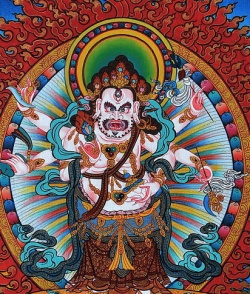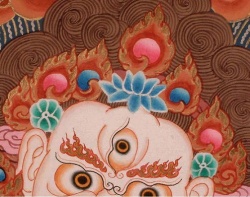White Mahakala (The Deity of Wealth and Prosperity)
White Mahakala is rare form of the wrathful Buddhist deity. He is associated with the attainment of wealth. The following description is according to his sadhana:
His body is white. His face is wrathful and he has three eyes. He has six arms. His main right hand holds a wish-fulfilling jewel mounted on a jewel-tipped handle, in front of his chest. This emblem is held by deities associated particularly with wealth.
His upper right hand holds a chopper. This crescent-shaped chopper, corresponds in shape to the cavity of the skullcup and functions to make 'mincemeat' of the hearts, intestines, lungs, and life-veins of enemies hostile to the Dharma. A similar crescent-shaped hand cleaver is used in oriental cuisine to chop meat and dice vegetables.
His lower right arm holds a hand drum, damaru in Sanskrit (Tib. Da ma ru, rnga chung). According to the strict rules of Tibetan-Buddhist iconography, the damaru is held and played in the right hand, and its function is to summon or invoke all of the Buddhas, inspiring them with supreme joy. The damaru as held by wrathful and semi-wrathful Buddhist deities, is described as being fashioned from the joined skulls of a fifteen or sixteen-year old boy and girl. The left side of the double-skull damaru is drawn smaller to represent the pubescent girl's skull. The magical qualities possessed by these skulls symbolize the virginal ripening to fullness of the male and female bodhichitta essences.
His lower left arm holds a skull-cup with a vase in it filled with many jewels. The skull-cup (Skt. Kapala; Tib. Thod phur)- fashioned from the oval upper section of a human cranium, serves as a libation vessel for wrathful and protective Vajrayana deities. As a receptacle for sacrificial offerings presented to wrathful deities, the kapala parallels the precious tray or bowl containing auspicious substances like the jewels shown here in this painting.
The central right hand holds a vajra hook. As a hand held weapon, the vajra hook symbolizes the hooking of negativities or evil beings, and the pulling or driving of all beings out of samsara and towards liberation.
The uppermost left hand holds a trident. As a weapon the trident symbolizes the destruction of the three poisons of ignorance, desire and aggression within the three realms. The two prongs uniting in the flaming central prong also symbolize the unity of method and wisdom; the abandonment of the two extremes of samsara and nirvana; and the ultimate union of absolute and relative truth.
He is adorned with jewelled ornaments and wears a beautiful skirt made of many scarves with jewels hanging down on the skirt.
Under each of his foot is a prostrate deity with an elephant head. This is symbolic of Lord Ganesha, the Hindu Lord of obstacles, thus representing the overcoming of obstacles.
Even though stationary in his stance, a lively movement is imparted through the agitated postures of his arms and the "Art-Nouveau" curves of his floating scarves.
The White Mahakala is more unusual than the customary black form. He is especially popular in Mongolia as the main protector deity of Mongolia., given such distinction by the third Dalai Lama.
The teachings of the White Mahakala were brought to Tibet in the eleventh century by Khedrup Khyungpopa, who also brought the teachings of the Six-armed Black Mahakala.
Performing the White Mahakala ritual is supposed to bring endless wealth to the needy practitioner in such things as family, material goods, food, power, knowledge, and spirituality.
In the present thangka the pot-bellied white complexioned Mahakala is standing on two elephant-headed figures on a lotus seat. The expression of his face is ferocious. His main right hand holds a flaming jewel in front of his chest, his upper right hand holds a vajra marked chopper and his lower right hand holds a drum with streaming ribbons. His main left arm rests on his left thigh and holds a skull cup with a vase in it filled with many jewels. His upper left hand holds a trident-tipped khatvanga staff, and his lower left hand holds a vajra hook. He wears silk scarves; elephant skin cloak, a garland of freshly severed human heads, and a tiger skin spread across his lower body below the bulging stomach. He is lavishly ornamented with exquisitely designed gold earrings, necklaces, armlets, bracelets, and girdle. His skirt is beautifully painted. As with the ornaments, gold is used to brighten the eyebrows of his two main eyes, his flaming mustache and his beard. His figure is brilliantly drawn and painted.
" . . . the different Mahakalas with various number of arms are not all the same. The Six-Armed version is the emanation of Chenrezig (in association with the head-blowing-up episode) and was originally the specialty of Shangpa Kagyu, but has now been adopted all over; one of the Four-Armed versions is an emanation of Chakrasamvara and the main protector of Karma Kagyu; the two-armed Bernakchen, an emanation of Samantabhadra, is actually not the main protector of Karma Kagyu, but rather that of the Karmapas specifically, although there is nothing that says the rest of us cannot also practice on him; the Sakyapa has the two-armed Panjaranatha Mahakala, who probably is an emanation of Manjushri and holds the rod that emanates many Mahakalas.

